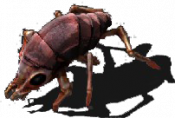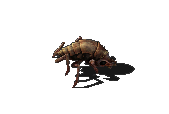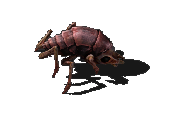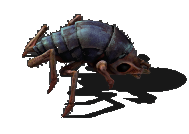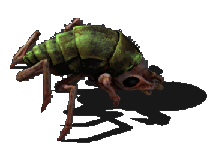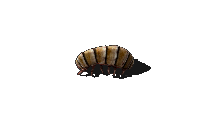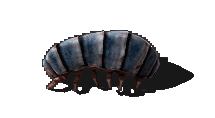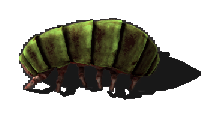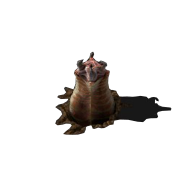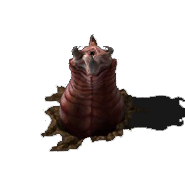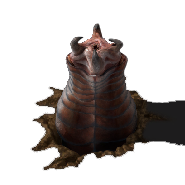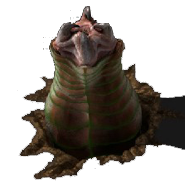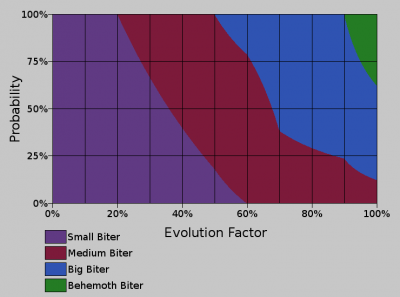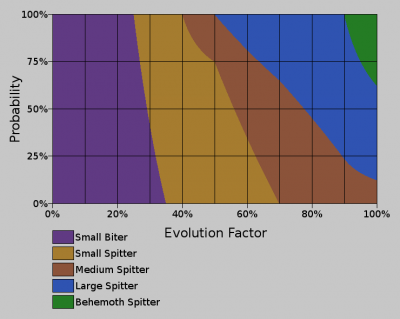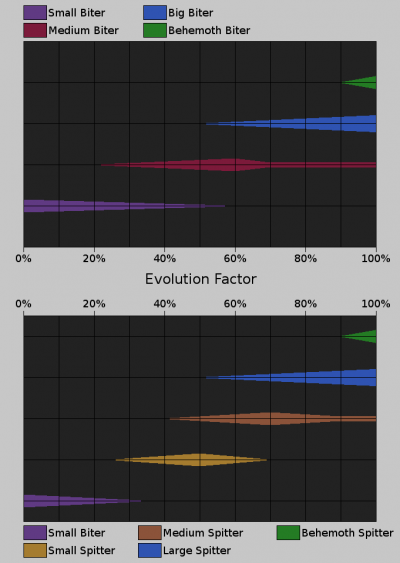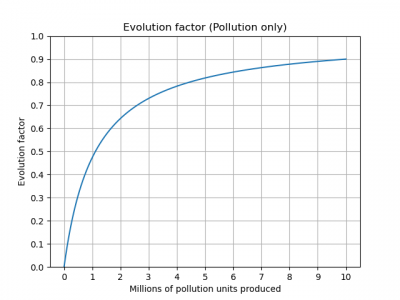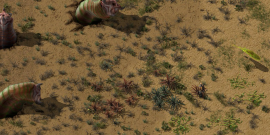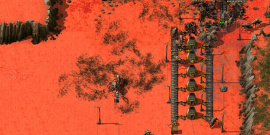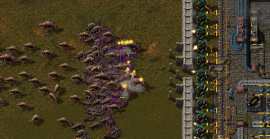Enemies: Difference between revisions
Thrawcheld (talk | contribs) (→Biters: correction) |
(→Advanced: Evolution factor components and computation: fixed formula) |
||
| (131 intermediate revisions by 32 users not shown) | |||
| Line 1: | Line 1: | ||
{{Languages}} | {{Languages}} | ||
'''Enemies''' are creatures that want to harm the player. They | [[File:biter_intro.png|175px|right]]'''Enemies''' (also commonly called '''Biters''') are creatures that want to [[Damage|harm]] the [[player]]. They are the native inhabitants of the extraterrestrial world in the form of arthropods living in organic nests, coexisting with each other peacefully. They are encountered in three species: Biters, spitters and worms. The species are further distinguished in four stages of growth, and thus strength. Enemies and nests show up on the map as red dots. Much like the player, enemies can slowly regain lost health. | ||
== Achievements == | |||
Enemies are directly connected to the following achievements: | |||
{{Achievement|it-stinks-and-they-dont-like-it}} | |||
{{Achievement|steamrolled}} | |||
==Creatures== | ==Creatures== | ||
===Biters=== | ===Biters=== | ||
Biters are one of two main antagonists in the game | Biters are one of two main antagonists in the game. They come in four sizes: small, medium, big and behemoth. In the beginning of a game, there will only be the small ones. With increasing [[pollution]], they will become bigger, related to the enemy's [[#Evolution|evolution]]. As common sense may suggest, their method of attack is a straightforward charge to "bite" things. | ||
{| class="wikitable" | {| class="wikitable" | ||
| Line 13: | Line 15: | ||
! Picture !! Name !! Info | ! Picture !! Name !! Info | ||
|- | |- | ||
| [[File: | | [[File:small_biter.png|center]] || Small Biter | ||
| Weakest of biters, can be easily killed with a pistol. | | Weakest of biters, can be easily killed with a pistol. | ||
* Health: 15 | * Health: 15 | ||
* Damage: | * Damage: 7 Physical | ||
* Attack speed: 1.71/s | |||
* Speed: 43.2km/h | |||
* Range: 1 | |||
* Pollution to join attack: 4 | |||
|- | |- | ||
| [[File: | | [[File:medium_biter.png|center]] || Medium Biter | ||
| Stronger and | | Stronger and slightly faster than the small biter. Can pose a problem for and even kill weaker players. | ||
* Health: 75 | * Health: 75 | ||
* Damage: 15 | * Damage: 15 Physical | ||
* Attack speed: 1.71/s | |||
* Speed: 51.8km/h | |||
* Range: 1 | |||
* Pollution to join attack: 20 | |||
Resistances: | [[Damage#Resistance|Resistances]]: | ||
*Explosion 0/10% | *Explosion: 0/10% | ||
*Physical 4/ | *Physical: 4/10% | ||
|- | |- | ||
| [[File: | | [[File:big_biter.png|center]] || Big Biter | ||
| | | Dangerous, resistant to small arms. Can attack through walls, hitting objects directly behind them. | ||
* Health: 375 | * Health: 375 | ||
* Damage: 30 | * Damage: 30 Physical | ||
* Attack speed: 1.71/s | |||
* Speed: 49.7km/h | |||
* Range: 2 | |||
* Pollution to join attack: 80 | |||
Resistances: | Resistances: | ||
*Explosion 0/10% | *Explosion: 0/10% | ||
*Physical 8/ | *Physical: 8/10% | ||
|- | |- | ||
| [[File: | | [[File:behemoth_biter.png|center]] || Behemoth Biter | ||
| | | Extremely durable and nearly immune to small arms, except for the strongest ordnance. Can attack through walls, hitting objects directly behind them. | ||
* Health: | * Health: 3000 | ||
* Damage: | * Damage: 90 Physical | ||
* Attack speed: 1.2/s | |||
* Speed: 64.8km/h | |||
* Range: 2 | |||
* Pollution to join attack: 400 | |||
Resistances: | Resistances: | ||
*Explosion 10 | *Explosion: 12/10% | ||
*Physical | *Physical: 12/10% | ||
|} | |} | ||
===Spitters=== | ===Spitters=== | ||
Spitters are much like Biters. | '''Spitters''' are much like [[Enemies#Biters|biters]] and only appear slightly later on in the game as the evolution factor increases. Their main difference from biters is their ranged attack. Using predictive aiming, they spit a stream of acid at enemies which leaves behind a puddle of acid where it hits the ground. Due to the spitters' predictive aiming, the acid stream can be dodged by suddenly changing walking directions or standing still.[https://factorio.com/blog/post/fff-279] Both the stream and the puddle of acid deal damage of time and slow down players and vehicles. Most entities of the game have a much lower resistance to acid than other damage types (including [[turret]]s and [[armor]]), so spitters are effectively more potent against the player and their factories. Their behaviour and size classification are the same as with biters, but their health is universally lower and they are resistant exclusively against explosives, with no physical resistance. | ||
{| class="wikitable" | {| class="wikitable" | ||
| Line 59: | Line 72: | ||
! Picture !! Name !! Info | ! Picture !! Name !! Info | ||
|- | |- | ||
| [[File: | | [[File:small_spitter.png|center]] || Small Spitter | ||
| Weakest of spitters. Easy to kill with any weapon, but attacks at range. | | Weakest of spitters. Easy to kill with any weapon, but attacks at range. | ||
* Health: 10 | * Health: 10 | ||
* Damage: | * Range: 13 | ||
* Pollution to join attack: 4 | |||
* Speed: 40.0km/h | |||
Acid projectile: | |||
* Attack speed: 0.6/s | |||
* Area of effect size: 1 | |||
* Damage (on contact): 12 Acid | |||
Acid puddle: | |||
* Lifetime: 32 seconds | |||
* Damage: 7.2 Acid/second | |||
* Applies effect (on contact): | |||
** Movement/vehicle speed modifier: 60% | |||
** Duration: 2 seconds | |||
|- | |- | ||
| [[File: | | [[File:medium_spitter.png|center]] || Medium Spitter | ||
| Stronger and slower than the smaller version. Can pose a problem for and even kill weaker players | | Stronger and slower than the smaller version. Can pose a problem for and even kill weaker players. | ||
* Health: 50 | * Health: 50 | ||
* Damage: | * Range: 14 | ||
* Pollution to join attack: 12 | |||
* Speed: 35.6km/h | |||
Acid projectile: | |||
* Attack speed: 0.6/s | |||
* Area of effect size: 1.25 | |||
* Damage (on contact): 24 Acid | |||
Acid puddle: | |||
* Lifetime: 32 seconds | |||
* Damage: 28.8 Acid/second | |||
* Applies effect (on contact): | |||
** Movement/vehicle speed modifier: 50% | |||
** Duration: 2 seconds | |||
Resistances: | Resistances: | ||
*Explosion 0/10% | *Explosion: 0/10% | ||
|- | |- | ||
| [[File: | | [[File:big_spitter.png|center]] || Big Spitter | ||
| | | An even bulkier spitter and so can take more damage. | ||
* Health: 200 | * Health: 200 | ||
* Damage: | * Range: 15 | ||
* Pollution to join attack: 30 | |||
* Speed: 32.4km/h | |||
Acid projectile: | |||
* Attack speed: 0.6/s | |||
* Area of effect size: 1.35 | |||
* Damage (on contact): 36 Acid | |||
Acid puddle: | |||
* Lifetime: 32 seconds | |||
* Damage: 130 Acid/second | |||
* Applies effect (on contact): | |||
** Movement/vehicle speed modifier: 40% | |||
** Duration: 2 seconds | |||
Resistances: | Resistances: | ||
*Explosion 0/ | *Explosion: 0/15% | ||
|- | |- | ||
| [[File: | | [[File:behemoth_spitter.png|center]] || Behemoth Spitter | ||
| The | | The bulkiest of the spitters and so can take even more damage. | ||
* | * Health: 1500 | ||
* Damage: | * Range: 16 | ||
* Pollution to join attack: 200 | |||
* Speed: 32.4km/h | |||
Acid projectile: | |||
* Attack speed: 0.6/s | |||
* Area of effect size: 1.75 | |||
* Damage (on contact): 60 Acid | |||
Acid puddle: | |||
* Lifetime: 32 seconds | |||
* Damage: 360 Acid/second | |||
* Applies effect (on contact): | |||
** Movement/vehicle speed modifier: 30% | |||
** Duration: 2 seconds | |||
Resistances: | Resistances: | ||
*Explosion 0/ | *Explosion: 0/30% | ||
|} | |} | ||
===Worms=== | ===Worms=== | ||
The Worms are natural allies of biters and spitters and will attack the player if they get close enough with an attack similar to spitters'. They act like static [[turret]]s and will not follow attackers. They rely on high damage, great range and splash damage to keep the player away from the worms and the nests they protect, but either one of these advantages can be overcome. Unlike other enemies, they are also highly resistant to fire. They will spit acid at the player, which can also leave acidic puddles on the ground that can still damage players and vehicles, as well as slow them both down and leave a brief acidic, damaging effect for a few seconds. However, placed buildings and tiles are unaffected by the acid puddles, but still take damage normally by the acid projectile. | |||
Worms | Worms come in 4 sizes, their power increasing with size. Like biters and spitters, behemoth, big and medium worms spawning is influenced by the evolution factor. Worms are only created during enemy expansion when a certain evolution factor requirement is fulfilled. This is 0.3 for the medium worm, 0.5 for the big worm and 0.9 for the behemoth worm. Below these evolution factors, worms can only be created by the map generation. In map generation, the game restricts higher tier worms behind the distance from the starting point. The further away the player goes from the starting area, the stronger the worms become. | ||
{| class="wikitable" | {| class="wikitable" | ||
|- | |- | ||
! Picture !! Name !! | ! Picture !! Name !! Info | ||
|- | |- | ||
| [[File: | | [[File:Small worm.png|center]] || Small Worm | ||
| A weak worm. | | A weak worm. It is still capable of killing the player unless it is targeted as priority. | ||
* Health: 200 | * Health: 200 | ||
* Damage: | * Range: 25 | ||
Acid projectile: | |||
* Attack speed: 0.66/s | |||
* Area of effect size: 1.4 | |||
* Damage (on contact): 36 Acid | |||
Acid puddle: | |||
* Lifetime: 32 seconds | |||
* Damage: 21.6 Acid/second | |||
* Applies effect (on contact): | |||
** Duration: 2 seconds | |||
** Movement/vehicle speed modifier: 60% | |||
|- | |- | ||
| [[File: | | [[File:Medium worm.png|center]] || Medium Worm | ||
| Medium worms are | | Medium worms are dangerous to even more advanced players. They should be handled with care. | ||
* Health: | * Health: 400 | ||
* Damage: | * Range: 30 | ||
Acid projectile: | |||
* Attack speed: 0.66/s | |||
* Area of effect size: 1.55 | |||
* Damage (on contact): 48 Acid | |||
Acid puddle: | |||
* Lifetime: 32 seconds | |||
* Damage: 57.6 Acid/second | |||
* Applies effect (on contact): | |||
** Duration: 2 seconds | |||
** Movement/vehicle speed modifier: 50% | |||
Resistances: | Resistances: | ||
*Explosion: 5/15% | *Explosion: 5/15% | ||
*Physical: | *Fire: 2/50% | ||
*Physical: 5/0% | |||
|- | |- | ||
| [[File: | | [[File:Big worm.png|center]] || Big Worm | ||
| Big worms are | | Big worms are not as much more dangerous as resilient. They are almost immune to common gunfire of any sort. | ||
* Health: | * Health: 750 | ||
* Damage: | * Range: 38 | ||
Acid projectile: | |||
* Attack speed: 0.66/s | |||
* Area of effect size: 1.75 | |||
* Damage (on contact): 72 Acid | |||
Acid puddle: | |||
* Lifetime: 32 seconds | |||
* Damage: 259 Acid/second | |||
* Applies effect (on contact): | |||
** Duration: 2 seconds | |||
** Movement/vehicle speed modifier: 40% | |||
Resistances: | Resistances: | ||
*Explosion: 10/30% | *Explosion: 10/30% | ||
*Physical: | *Fire: 3/70% | ||
*Physical: 10/0% | |||
|- | |||
| [[File:Behemoth worm.png|center]] || Behemoth Worm | |||
| Behemoth worms are the most dangerous of worms. They are just as resilient as Big worms, with much greater range. | |||
* Health: 750 | |||
* Range: 48 | |||
Acid projectile: | |||
* Attack speed: 0.66/s | |||
* Area of effect size: 2 | |||
* Damage (on contact): 96 Acid | |||
Acid puddle: | |||
* Lifetime: 32 seconds | |||
* Damage: 691 Acid/second | |||
* Applies effect (on contact): | |||
** Duration: 2 seconds | |||
** Movement/vehicle speed modifier: 30% | |||
Resistances: | |||
*Acid: 0/100% | |||
*Explosion: 10/30% | |||
*Fire: 3/70% | |||
*Physical: 10/0% | |||
|} | |} | ||
{| class="wikitable" | {| class="wikitable" | ||
|- | |- | ||
! Picture !! | ! Picture !! Description | ||
|- | |- | ||
| [[File:worm.gif]] || | | [[File:worm.gif]] || A worm's attack animation. | ||
|- | |- | ||
|} | |} | ||
== | ==Nests== | ||
The spawn points of biters and spitters. While nests themselves are generally defenseless, the enemies they release over time effectively serve as a form of guards to distract the player and any nearby turrets, and are often accompanied by worms. Nests exposed to pollution will use it to send enemies to join attacks. Enemies not engaged in combat may seek out the nearest nest for protection. | |||
The nests are highly resistant to fire and otherwise generally more resilient than a medium worm. | |||
{| class="wikitable" | {| class="wikitable" | ||
|- | |- | ||
! Picture !! Name | ! Picture !! Name !! Description | ||
|- | |- | ||
| [[File: | | [[File:biter_nest.png]] || Biter's nest | ||
| | | | ||
* Health: 350 | * Health: 350 | ||
| Line 142: | Line 278: | ||
Resistances: | Resistances: | ||
*Explosion: 5/15% | *Explosion: 5/15% | ||
*Physical: 2/ | *Fire: 3/60% | ||
*Physical: 2/15% | |||
|- | |- | ||
| [[File: | | [[File:spitter_nest.png]] || Spitter's nest | ||
| | | | ||
* Health: 350 | * Health: 350 | ||
| Line 150: | Line 287: | ||
Resistances: | Resistances: | ||
*Explosion: 5/15% | *Explosion: 5/15% | ||
*Physical: 2/ | *Fire: 3/60% | ||
*Physical: 2/15% | |||
|} | |} | ||
=== | === Expansions === | ||
The game evolution factor is a global variable that determines what kind of biters will be spawned. You can check the variable in the dev console: | Every 4-60 minutes, a group of 5-20 biters/spitters will leave their base to create a new base which will consist of as many worms/nests as there are members in the group. This group will search for a suitable spot that's 3-7 chunks away from existing bases. The interval between enemy expansions is global, and the higher enemy evolution, the shorter the interval is on average. Furthermore, with higher evolution, the groups are bigger on average. | ||
Once they have found a suitable spot, each biter/spitter in the group dies and forms a new nest or worm. Forming a new nest or worm will destroy anything that is in the way, which can include members of the expansion group. There is a delay between each member sacrificing itself for to create a worm/nest, so creating the new base from the expansion group can take quite a long time, depending on the group size. Medium worms are only formed if the current evolution is higher than 0.3, big worms only if the current evolution is higher than 0.5 and behemoth worms are only formed if current evolution is higher than 0.9. The game randomly chooses whether to form a new biter nest, spitter nest, small worm, or bigger worm if the evolution factor is high enough. [https://gist.github.com/Bilka2/aa88490c23124a6f214c02c73a368aa7] | |||
==Defense== | |||
[[File:kills_gui.png|thumb|220px|right|"Kills" tab on the [[production statistics]] screen.]]Nests spawn biters and spitters freely. However, biters and spitters will only aggressively engage the player's factory if the pollution cloud of the factory reaches a nest because pollution is consumed to send biters or spitters to join the next attack. Every 1 to 10 minutes (random) the mustered biters launch an attack. If not all biters have arrived at the rendezvous point by that time, they will wait up to an additional 2 minutes for stragglers. The attack then proceeds to their target over the shortest path possible, accounting for terrain, but not for player entities that could pose an obstacle (like [[wall]]s). | |||
If there is a clear path somewhere around those obstacles, the biters will attempt to go around. If there is no clear passage or a clear passage would mean deviating too far from the original course, the biters will attack whatever is in their way to go through. This can be exploited to an extent; creating mazes at regular intervals along a barrier can direct the biters through a gauntlet not dissimilar to tower defense. | |||
However, if a biter comes in proximity of a [[Military units and structures|military unit or structure]], it will prioritize these and attempt to immediately attack them instead, again trying to reach the new target over the shortest possible path with no too great detours, if possible. | |||
==Evolution== | |||
[[File:Evolution Biters.png|thumb|right|400px|Spawn chances of biters from biter spawners by evolution factor.]] | |||
[[File:Evolution Spitters.png|thumb|right|400px|Spawn chances of spitters from spitter spawners by evolution factor.]] | |||
[[File:Evolution Weights.png|thumb|right|400px|Weight graph of both spawners by evolution factor. The values shown are primarily for indicating when certain types start and stop spawning, for actual chances refer to the tables or other charts.]] | |||
The evolution factor is a global variable that determines what kind of biters will be spawned. You can check the variable in the dev console via the following command (does not disable achievements): | |||
/evolution | |||
The evolution factor goes from 0 (not evolved at all) to 1 (maximal evolution). The evolution factor can only increase. | |||
This command also provides percentages for the three sources; each one is the percent of the (unsquashed) total evolution that is contributed by that source. | |||
Besides choosing what kind of biter will be spawned, the evolution factor also influences the spawning interval. This interval (<code>spawning_cooldown</code> in the <code>enemy-spawner</code> definition) is interpolated between 360 (0 evolution) and 150 (1 evolution) game ticks (= 6 to 2.5 seconds). | |||
=== Methods of increasing === | |||
The evolution factor is increased by three kinds of events: | |||
* The passage of time very slightly increases the evolution factor. | * The passage of time very slightly increases the evolution factor. | ||
* The global [[Pollution | * The global [[Pollution|pollution production]] increases the evolution factor. | ||
* Destroying the enemy spawners | * Destroying [[Enemies#Nests|nests]] significantly increases the evolution factor. | ||
The default settings are: | |||
{| class="wikitable" | |||
!Source per | |||
!Variable in <code>enemy_evolution</code> | |||
!Evolution increase | |||
|- | |||
| [[Time#Seconds|Second]] || <code>time_factor</code> || 0.000004 | |||
|- | |||
| Destroyed enemy spawner || <code>destroy_factor</code> || 0.002 | |||
|- | |||
| 1 Pollution unit || <code>pollution_factor</code> || 0.0000009 | |||
|} | |||
These values can be set during [[Map_generator#Enemy|world generation]]: the values in the dialog box are multiplied by 10^-7 for time and pollution, and 10^-5 for spawner destruction. In game, they can be found in <code>game.map_settings.enemy_evolution</code>, though checking or modifying them is considered using cheats. | |||
Pollution production is the total pollution produced by [[Pollution#Polluters|buildings]], not the pollution spreading on the map, so it is not reduced by trees or other absorbers. | |||
e.g. : 10 boilers produce 300 pollution in one minute, raising the evolution factor by around 0.00027 in that minute. | |||
After totaling up all the evolution from these sources, this quantity is squashed to fit in the range <code>[0, 1)</code> by applying <code>evolution_factor = total_evolution / (1 + total_evolution)</code>. | |||
Equivalently, marginal increases in evolution are reduced by multiplying the increase by <code>(1 - evolution_factor)²</code>. So for instance destroying enemy spawners in the beginning of the game results in increase of evolution factor by 0.002 while doing this when the evolution factor is 0.5 the increase is only 0.0005. | |||
This also means that the evolution factor approaches 1 asymptotically - generally, increases past 0.9 or so are ''very'' slow and the number never actually reaches 1.0. | |||
=== Spawn chances by evolution factor === | |||
The probability charts show the chances of each type of biter/spitter for each spawner at all evolution levels. | |||
<div id="evoChecker"></div> | |||
=== Advanced: Evolution factor components and computation === | |||
<div class="toccolours mw-collapsible mw-collapsed" style="width:calc(100%-400px); overflow:auto;"> | |||
This section has charts plotting the individual evolution factor components and discusses possibilities for manually estimating the evolution factor. | |||
<div class="mw-collapsible-content"> | |||
[[File:Evolution_factor_by_time.png|400px|thumb|right|1. Single-component evolution factor increase with time]] | |||
[[File:Evolution_factor_by_spawners.png|400px|thumb|right|2. Single-component evolution factor increase with destroyed spawners]] | |||
[[File:Evolution_factor_by_pollution.png|400px|thumb|right|3. Single-component evolution factor increase with pollution]] | |||
'''Notes''' | |||
* Data from version 1.1.50. | |||
* All charts end at approximately an evolution factor of 0.90. | |||
* The calculation steps for time and spawner kills match those used by the game, so these charts should be accurate. The pollution chart assumes a pollution production of 1000 units per second, and due to the recursive nature of the chart values will slightly diverge at different pollution rates. The effect of this is negligible for any reasonable amount pollution production, however. | |||
* Given that the game reports the actual evolution factor (console: <code>/evolution</code>) whenever the player wishes, these charts are intended primarily to help estimate the impact of planned base expansions and similar activities on the evolution factor's future development. | |||
'''Comments''' | |||
These charts (click to enlarge) represent the situation where each evolution factor component (time, pollution, destroyed spawners) is the ''only'' component contributing to the evolution factor in that entire game. They are therefore '''not realistic''', as in a typical game all three components will contribute, some at varying times and intensities. | |||
Because of how contributions to the evolution factor (EF) are calculated (multiplied by <code>(1 - current EF)</code>), it is '''not''' possible to simply add the values indicated by these charts for a game's time passed, pollution generated, and / or spawners destroyed so far to retrieve the total evolution factor. | |||
For example, if 24 hours have passed (single-component EF =~ 0.25), 200,000 pollution units were released (single-component EF =~ 0.15), and 400 spawners were destroyed (single-component EF =~ 0.45), the actual evolution factor will '''not''' be (0.25 + 0.15 + 0.45 =) ~0.85. | |||
However, the evolution factor will always be '''less''' than the sum of all individual components as indicated by these charts, and '''at least''' as high as the highest individual component. Thus, using the values from above, the EF will be ''at least'' 0.35 and ''less than'' 0.85. A smarter approach is required to compute the current evolution factor. | |||
'''Individual components''' | |||
The individual components of evolution can be approximated from <code>/evolution</code>: | |||
Given the evolution factor, the unsquashed evolution is <code>unsquashed = evolution_factor / (1 - evolution_factor)</code>. Multiply this by the percentage for a given component to get its approximate unsquashed contribution. Of course, total pollution and spawner kills can also be found on the [[Production_statistics|production statistics]] screen, and time passed can be found using the <code>/time</code> command, so it's not fully necessary. | |||
The actual factors can be found in <code>game.forces.enemy.evolution_factor_by_time</code>, <code>...evolution_factor_by_killing_spawners</code>, and <code>...evolution_factor_by_pollution</code>, if you don't mind disabling achievements. | |||
</div></div> | |||
== Gallery == | |||
<gallery widths=270px heights=140px> | |||
File:player_near_enemy_nests.png|The player near some enemy nests and worms. | |||
File:player_worms_acid.png|The player among acid puddles created by attacking worms. | |||
File:player_attacked_by_biters.png|Both the player and some buildings getting attacked by biters. | |||
File:enemy_nests_mapgen.png|Enemy nests seen in a map generation preview (deathworld setting). | |||
File:turret_wall_biters.png|Line of gun turrets defending against biters. | |||
File:titlescreen_enemies.png|Enemies seen at the title screen. | |||
</gallery> | |||
== History == | |||
{{history|0.17.0| | |||
* Behemoth worm added.}} | |||
{{history|0.15.0| | |||
* Increased the damage, range, and health of worms. | |||
* Decreased health and resist of Behemoth biters.}} | |||
{{history|0.13.10| | |||
* Biters and other units won't become aggressive as a result of friendly-fire.}} | |||
0. | {{history|0.13.0| | ||
* Big and behemoth enemies now spawn 50% slower. | |||
* Changed the way evolution factor approaches the maximum (1). | |||
** The addition of evolution factor was changed from addition * (1 - evolution) to addition * (1 - evolution)^2 | |||
** This means that the progress gets more slower towards the high values.}} | |||
{{history|0.12.26| | |||
* Running biters over with a vehicle will now anger them in peaceful mode.}} | |||
0. | {{history|0.12.0| | ||
* Updated sounds for enemies.}} | |||
{{history|0.11.17| | |||
* Items dropped by enemies([[alien artifact|*]]) are now collected automatically and from longer distances.}} | |||
0. | {{history|0.11.6| | ||
* Range of spitters is now 15, less than turrets.}} | |||
{{history|0.11.0| | |||
* Spitters added. | |||
* Drawing of enemies optimised, so adding new colors does not impact VRAM. | |||
* Blood splashes on death are now procedural.}} | |||
{{history|0.9.0| | |||
* Turrets no longer search for enemies when none are near. | |||
* Biters can no longer destroy the shipwreck in the 3rd new hope campaign.}} | |||
{{history|0.8.1| | |||
* Further improvement to enemy AI.}} | |||
{{history|0.8.0| | |||
* Decreased the range of medium worm from 25 to 20.}} | |||
{{history|0.7.2| | |||
* Biter AI improved.}} | |||
{{history|0.7.1| | |||
* Peaceful mode added for freeplay.}} | |||
{{history|0.7.0| | |||
{| | * Enemy creepers were replaced by small, medium and big biters. | ||
* Enemy turrets were replaced by small, medium and big shooting worms. | |||
* Enemies move and attack in groups. | |||
* Enemies wander around their base when they have nothing to do. | |||
* Enemies call for help when attacked. | |||
* Enemies can create new bases. | |||
* Enemies can now destroy all player creations they find.}} | |||
{ | {{history|0.1.0| | ||
* Introduced, called 'creepers'}} | |||
|0 | |||
== | == See also == | ||
* [[Damage]] | |||
* [[Pollution]] | |||
Latest revision as of 08:31, 22 January 2023
Enemies (also commonly called Biters) are creatures that want to harm the player. They are the native inhabitants of the extraterrestrial world in the form of arthropods living in organic nests, coexisting with each other peacefully. They are encountered in three species: Biters, spitters and worms. The species are further distinguished in four stages of growth, and thus strength. Enemies and nests show up on the map as red dots. Much like the player, enemies can slowly regain lost health.
Achievements
Enemies are directly connected to the following achievements:

|
It stinks and they dont like it |

|
Steamrolled Destroy 10 spawners by impact. |
Creatures
Biters
Biters are one of two main antagonists in the game. They come in four sizes: small, medium, big and behemoth. In the beginning of a game, there will only be the small ones. With increasing pollution, they will become bigger, related to the enemy's evolution. As common sense may suggest, their method of attack is a straightforward charge to "bite" things.
| Picture | Name | Info |
|---|---|---|
| Small Biter | Weakest of biters, can be easily killed with a pistol.
| |
| Medium Biter | Stronger and slightly faster than the small biter. Can pose a problem for and even kill weaker players.
| |
| Big Biter | Dangerous, resistant to small arms. Can attack through walls, hitting objects directly behind them.
Resistances:
| |
| Behemoth Biter | Extremely durable and nearly immune to small arms, except for the strongest ordnance. Can attack through walls, hitting objects directly behind them.
Resistances:
|
Spitters
Spitters are much like biters and only appear slightly later on in the game as the evolution factor increases. Their main difference from biters is their ranged attack. Using predictive aiming, they spit a stream of acid at enemies which leaves behind a puddle of acid where it hits the ground. Due to the spitters' predictive aiming, the acid stream can be dodged by suddenly changing walking directions or standing still.[1] Both the stream and the puddle of acid deal damage of time and slow down players and vehicles. Most entities of the game have a much lower resistance to acid than other damage types (including turrets and armor), so spitters are effectively more potent against the player and their factories. Their behaviour and size classification are the same as with biters, but their health is universally lower and they are resistant exclusively against explosives, with no physical resistance.
| Picture | Name | Info |
|---|---|---|
| Small Spitter | Weakest of spitters. Easy to kill with any weapon, but attacks at range.
Acid projectile:
Acid puddle:
| |
| Medium Spitter | Stronger and slower than the smaller version. Can pose a problem for and even kill weaker players.
Acid projectile:
Acid puddle:
Resistances:
| |
| Big Spitter | An even bulkier spitter and so can take more damage.
Acid projectile:
Acid puddle:
Resistances:
| |
| Behemoth Spitter | The bulkiest of the spitters and so can take even more damage.
Acid projectile:
Acid puddle:
Resistances:
|
Worms
The Worms are natural allies of biters and spitters and will attack the player if they get close enough with an attack similar to spitters'. They act like static turrets and will not follow attackers. They rely on high damage, great range and splash damage to keep the player away from the worms and the nests they protect, but either one of these advantages can be overcome. Unlike other enemies, they are also highly resistant to fire. They will spit acid at the player, which can also leave acidic puddles on the ground that can still damage players and vehicles, as well as slow them both down and leave a brief acidic, damaging effect for a few seconds. However, placed buildings and tiles are unaffected by the acid puddles, but still take damage normally by the acid projectile.
Worms come in 4 sizes, their power increasing with size. Like biters and spitters, behemoth, big and medium worms spawning is influenced by the evolution factor. Worms are only created during enemy expansion when a certain evolution factor requirement is fulfilled. This is 0.3 for the medium worm, 0.5 for the big worm and 0.9 for the behemoth worm. Below these evolution factors, worms can only be created by the map generation. In map generation, the game restricts higher tier worms behind the distance from the starting point. The further away the player goes from the starting area, the stronger the worms become.
| Picture | Name | Info |
|---|---|---|
| Small Worm | A weak worm. It is still capable of killing the player unless it is targeted as priority.
Acid projectile:
Acid puddle:
| |
| Medium Worm | Medium worms are dangerous to even more advanced players. They should be handled with care.
Acid projectile:
Acid puddle:
Resistances:
| |
| Big Worm | Big worms are not as much more dangerous as resilient. They are almost immune to common gunfire of any sort.
Acid projectile:
Acid puddle:
Resistances:
| |
| Behemoth Worm | Behemoth worms are the most dangerous of worms. They are just as resilient as Big worms, with much greater range.
Acid projectile:
Acid puddle:
Resistances:
|
| Picture | Description |
|---|---|
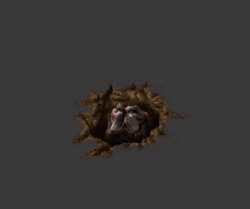 |
A worm's attack animation. |
Nests
The spawn points of biters and spitters. While nests themselves are generally defenseless, the enemies they release over time effectively serve as a form of guards to distract the player and any nearby turrets, and are often accompanied by worms. Nests exposed to pollution will use it to send enemies to join attacks. Enemies not engaged in combat may seek out the nearest nest for protection.
The nests are highly resistant to fire and otherwise generally more resilient than a medium worm.
| Picture | Name | Description |
|---|---|---|
 |
Biter's nest |
Resistances:
|
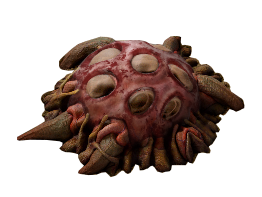 |
Spitter's nest |
Resistances:
|
Expansions
Every 4-60 minutes, a group of 5-20 biters/spitters will leave their base to create a new base which will consist of as many worms/nests as there are members in the group. This group will search for a suitable spot that's 3-7 chunks away from existing bases. The interval between enemy expansions is global, and the higher enemy evolution, the shorter the interval is on average. Furthermore, with higher evolution, the groups are bigger on average.
Once they have found a suitable spot, each biter/spitter in the group dies and forms a new nest or worm. Forming a new nest or worm will destroy anything that is in the way, which can include members of the expansion group. There is a delay between each member sacrificing itself for to create a worm/nest, so creating the new base from the expansion group can take quite a long time, depending on the group size. Medium worms are only formed if the current evolution is higher than 0.3, big worms only if the current evolution is higher than 0.5 and behemoth worms are only formed if current evolution is higher than 0.9. The game randomly chooses whether to form a new biter nest, spitter nest, small worm, or bigger worm if the evolution factor is high enough. [2]
Defense
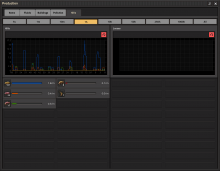
Nests spawn biters and spitters freely. However, biters and spitters will only aggressively engage the player's factory if the pollution cloud of the factory reaches a nest because pollution is consumed to send biters or spitters to join the next attack. Every 1 to 10 minutes (random) the mustered biters launch an attack. If not all biters have arrived at the rendezvous point by that time, they will wait up to an additional 2 minutes for stragglers. The attack then proceeds to their target over the shortest path possible, accounting for terrain, but not for player entities that could pose an obstacle (like walls).
If there is a clear path somewhere around those obstacles, the biters will attempt to go around. If there is no clear passage or a clear passage would mean deviating too far from the original course, the biters will attack whatever is in their way to go through. This can be exploited to an extent; creating mazes at regular intervals along a barrier can direct the biters through a gauntlet not dissimilar to tower defense.
However, if a biter comes in proximity of a military unit or structure, it will prioritize these and attempt to immediately attack them instead, again trying to reach the new target over the shortest possible path with no too great detours, if possible.
Evolution
The evolution factor is a global variable that determines what kind of biters will be spawned. You can check the variable in the dev console via the following command (does not disable achievements):
/evolution
The evolution factor goes from 0 (not evolved at all) to 1 (maximal evolution). The evolution factor can only increase.
This command also provides percentages for the three sources; each one is the percent of the (unsquashed) total evolution that is contributed by that source.
Besides choosing what kind of biter will be spawned, the evolution factor also influences the spawning interval. This interval (spawning_cooldown in the enemy-spawner definition) is interpolated between 360 (0 evolution) and 150 (1 evolution) game ticks (= 6 to 2.5 seconds).
Methods of increasing
The evolution factor is increased by three kinds of events:
- The passage of time very slightly increases the evolution factor.
- The global pollution production increases the evolution factor.
- Destroying nests significantly increases the evolution factor.
The default settings are:
| Source per | Variable in enemy_evolution
|
Evolution increase |
|---|---|---|
| Second | time_factor |
0.000004 |
| Destroyed enemy spawner | destroy_factor |
0.002 |
| 1 Pollution unit | pollution_factor |
0.0000009 |
These values can be set during world generation: the values in the dialog box are multiplied by 10^-7 for time and pollution, and 10^-5 for spawner destruction. In game, they can be found in game.map_settings.enemy_evolution, though checking or modifying them is considered using cheats.
Pollution production is the total pollution produced by buildings, not the pollution spreading on the map, so it is not reduced by trees or other absorbers. e.g. : 10 boilers produce 300 pollution in one minute, raising the evolution factor by around 0.00027 in that minute.
After totaling up all the evolution from these sources, this quantity is squashed to fit in the range [0, 1) by applying evolution_factor = total_evolution / (1 + total_evolution).
Equivalently, marginal increases in evolution are reduced by multiplying the increase by (1 - evolution_factor)². So for instance destroying enemy spawners in the beginning of the game results in increase of evolution factor by 0.002 while doing this when the evolution factor is 0.5 the increase is only 0.0005.
This also means that the evolution factor approaches 1 asymptotically - generally, increases past 0.9 or so are very slow and the number never actually reaches 1.0.
Spawn chances by evolution factor
The probability charts show the chances of each type of biter/spitter for each spawner at all evolution levels.
Advanced: Evolution factor components and computation
This section has charts plotting the individual evolution factor components and discusses possibilities for manually estimating the evolution factor.
Notes
- Data from version 1.1.50.
- All charts end at approximately an evolution factor of 0.90.
- The calculation steps for time and spawner kills match those used by the game, so these charts should be accurate. The pollution chart assumes a pollution production of 1000 units per second, and due to the recursive nature of the chart values will slightly diverge at different pollution rates. The effect of this is negligible for any reasonable amount pollution production, however.
- Given that the game reports the actual evolution factor (console:
/evolution) whenever the player wishes, these charts are intended primarily to help estimate the impact of planned base expansions and similar activities on the evolution factor's future development.
Comments
These charts (click to enlarge) represent the situation where each evolution factor component (time, pollution, destroyed spawners) is the only component contributing to the evolution factor in that entire game. They are therefore not realistic, as in a typical game all three components will contribute, some at varying times and intensities.
Because of how contributions to the evolution factor (EF) are calculated (multiplied by (1 - current EF)), it is not possible to simply add the values indicated by these charts for a game's time passed, pollution generated, and / or spawners destroyed so far to retrieve the total evolution factor.
For example, if 24 hours have passed (single-component EF =~ 0.25), 200,000 pollution units were released (single-component EF =~ 0.15), and 400 spawners were destroyed (single-component EF =~ 0.45), the actual evolution factor will not be (0.25 + 0.15 + 0.45 =) ~0.85.
However, the evolution factor will always be less than the sum of all individual components as indicated by these charts, and at least as high as the highest individual component. Thus, using the values from above, the EF will be at least 0.35 and less than 0.85. A smarter approach is required to compute the current evolution factor.
Individual components
The individual components of evolution can be approximated from /evolution:
Given the evolution factor, the unsquashed evolution is unsquashed = evolution_factor / (1 - evolution_factor). Multiply this by the percentage for a given component to get its approximate unsquashed contribution. Of course, total pollution and spawner kills can also be found on the production statistics screen, and time passed can be found using the /time command, so it's not fully necessary.
The actual factors can be found in game.forces.enemy.evolution_factor_by_time, ...evolution_factor_by_killing_spawners, and ...evolution_factor_by_pollution, if you don't mind disabling achievements.
Gallery
History
- 0.17.0:
- Behemoth worm added.
- 0.15.0:
- Increased the damage, range, and health of worms.
- Decreased health and resist of Behemoth biters.
- 0.13.10:
- Biters and other units won't become aggressive as a result of friendly-fire.
- 0.13.0:
- Big and behemoth enemies now spawn 50% slower.
- Changed the way evolution factor approaches the maximum (1).
- The addition of evolution factor was changed from addition * (1 - evolution) to addition * (1 - evolution)^2
- This means that the progress gets more slower towards the high values.
- 0.12.26:
- Running biters over with a vehicle will now anger them in peaceful mode.
- 0.12.0:
- Updated sounds for enemies.
- 0.11.6:
- Range of spitters is now 15, less than turrets.
- 0.11.0:
- Spitters added.
- Drawing of enemies optimised, so adding new colors does not impact VRAM.
- Blood splashes on death are now procedural.
- 0.9.0:
- Turrets no longer search for enemies when none are near.
- Biters can no longer destroy the shipwreck in the 3rd new hope campaign.
- 0.8.1:
- Further improvement to enemy AI.
- 0.8.0:
- Decreased the range of medium worm from 25 to 20.
- 0.7.2:
- Biter AI improved.
- 0.7.1:
- Peaceful mode added for freeplay.
- 0.7.0:
- Enemy creepers were replaced by small, medium and big biters.
- Enemy turrets were replaced by small, medium and big shooting worms.
- Enemies move and attack in groups.
- Enemies wander around their base when they have nothing to do.
- Enemies call for help when attacked.
- Enemies can create new bases.
- Enemies can now destroy all player creations they find.
- 0.1.0:
- Introduced, called 'creepers'
